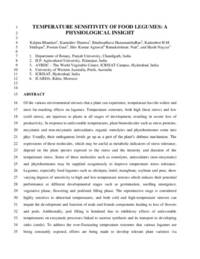Temperature sensitivity of food legumes: a physiological insight

Authors:
Of the various environmental stresses that a
plant can experience, temperature has the widest and most
far-reaching effects on legumes. Temperature extremes,
both high (heat stress) and low (cold stress), are injurious to
plants at all stages of development, resulting in severe loss
of productivity. In response to unfavorable temperatures,
plant biomolecules such as stress proteins, enzymatic and
non-enzymatic antioxidants, organic osmolytes and phytohormones
come into play, usually, as a part of the plant
defense mechanisms. The accumulation of these molecules,
which may be useful as metabolic indicators of stress
tolerance, depend on the plant species exposed to the
temperature stress, its intensity and duration. Some of these
molecules such as osmolytes, non-enzymatic antioxidants
and phytohormones may be supplied exogenously to
improve temperature stress tolerance. Legumes show
varying degrees of sensitivity to high and low-temperature
stresses, which reduces their potential performance at
various developmental stages. To address the ever-fluctuating
temperature extremes that various legumes are being
constantly exposed, efforts are being made to develop
tolerant plant varieties via conventional breeding methods
as well as more recent molecular breeding techniques. In
this review, we describe the progress made towards the
adverse effects of abnormal temperatures on various
growth stages in legumes and propose appropriate strategies
to resolve these effects.
